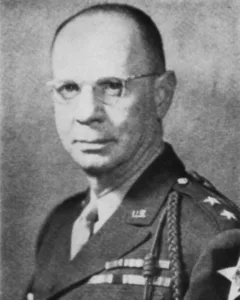Walter McConnell Robertson
Biography
Walter M. Robertson was a distinguished American military leader, best known for commanding the U.S. 2nd Infantry Division during World War II.
Early Life and Education
Walter M. Robertson was born on October 15, 1903, in Noblesville, Indiana. He grew up in a modest family and developed an early interest in military service. After graduating from high school, he attended the United States Military Academy at West Point in 1924, where he excelled in his studies and athletic pursuits. He graduated in 1928, ranking in the upper third of his class.
Early Military Career
After graduation, Robertson was assigned to the Infantry and served in various units in the United States and abroad. He participated in missions in China and the Philippines in the 1930s, gaining valuable experience in leadership and military tactics. In 1940, he was promoted to captain and began preparing for the impending global conflict.
World War II
When the United States entered World War II in 1941, Robertson was assigned to the General Staff. However, his leadership skills were quickly recognized, and he was soon appointed battalion commander in the 2nd Infantry Division. In 1943, he took command of the 2nd Infantry Division, a prestigious unit that played a key role in several major campaigns in Europe.
Notable Operations
- D-Day Landing (1944): The 2nd Infantry Division participated in the assault on Omaha Beach, one of the bloodiest landings on D-Day. Under Robertson’s command, the division managed to establish a beachhead despite heavy casualties.
- Battle of the Hedgerows: Robertson led his troops effectively in the difficult fighting against German defenses in Normandy.
- Liberation of France and the Netherlands: The division advanced through France, participated in the liberation of Paris, and contributed to the liberation of the Netherlands.
- Battle of the Hürtgen Forest (1944–1945): Robertson led his men in one of the war’s deadliest battles, where harsh conditions and fierce German resistance made combat extremely difficult.
- Crossing the Rhine and End of the War: The 2nd Division played a crucial role in crossing the Rhine and the final push into Germany, contributing to Germany’s surrender in May 1945.
Post-World War II Career
After the war, Robertson remained in the military and held several important command positions. He was promoted to brigadier general in 1948 and major general in 1951. During the Korean War, he served as commander of the 45th Infantry Division and later as chief of staff of the 8th Army. He was also involved in the training and modernization of U.S. armed forces.
Diplomatic and Political Career
In the 1950s, Robertson left the military for a career in diplomacy. He was appointed U.S. Ambassador to Belgium (1954–1957) and the Dominican Republic (1957–1960). He played a significant role in international relations and U.S. foreign policy during the Cold War.
Retirement and Legacy
Robertson retired in 1960 and settled in Virginia, where he wrote his memoirs and participated in military history conferences. He received numerous honors, including the Distinguished Service Cross, the Silver Star, and the Legion of Merit. He passed away on August 13, 2005, at the age of 101, leaving behind a legacy of exemplary leadership and service.
Honors and Awards
- Distinguished Service Cross
- Silver Star
- Legion of Merit
- Purple Heart
- Commander of the Legion of Honor (France)
![]() Back to US Military biographies menu
Back to US Military biographies menu

